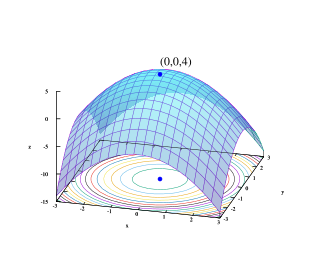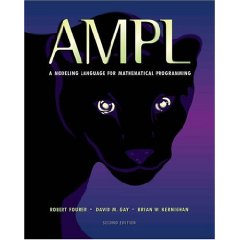Related Research Articles

Mathematical optimization or mathematical programming is the selection of a best element, with regard to some criterion, from some set of available alternatives. Optimization problems of sorts arise in all quantitative disciplines from computer science and engineering to operations research and economics, and the development of solution methods has been of interest in mathematics for centuries.

AMPL is an algebraic modeling language to describe and solve high-complexity problems for large-scale mathematical computing . It was developed by Robert Fourer, David Gay, and Brian Kernighan at Bell Laboratories. AMPL supports dozens of solvers, both open source and commercial software, including CBC, CPLEX, FortMP, MINOS, IPOPT, SNOPT, KNITRO, and LGO. Problems are passed to solvers as nl files. AMPL is used by more than 100 corporate clients, and by government agencies and academic institutions.
Computational science, also known as scientific computing or scientific computation (SC), is a field in mathematics that uses advanced computing capabilities to understand and solve complex problems. It is an area of science that spans many disciplines, but at its core, it involves the development of models and simulations to understand natural systems.

Computational Infrastructure for Operations Research (COIN-OR), is a project that aims to "create for mathematical software what the open literature is for mathematical theory." The open literature provides the operations research (OR) community with a peer-review process and an archive. Papers in operations research journals on mathematical theory often contain supporting numerical results from computational studies. The software implementations, models, and data used to produce the numerical results are typically not published. The status quo impeded researchers needing to reproduce computational results, make fair comparisons, and extend the state of the art.
The TOMLAB Optimization Environment is a modeling platform for solving applied optimization problems in MATLAB.
Algebraic modeling languages (AML) are high-level computer programming languages for describing and solving high complexity problems for large scale mathematical computation. One particular advantage of some algebraic modeling languages like AIMMS, AMPL, GAMS, Gekko, MathProg, Mosel, and OPL is the similarity of their syntax to the mathematical notation of optimization problems. This allows for a very concise and readable definition of problems in the domain of optimization, which is supported by certain language elements like sets, indices, algebraic expressions, powerful sparse index and data handling variables, constraints with arbitrary names. The algebraic formulation of a model does not contain any hints how to process it.
Advanced process monitor (APMonitor) is a modeling language for differential algebraic (DAE) equations. It is a free web-service or local server for solving representations of physical systems in the form of implicit DAE models. APMonitor is suited for large-scale problems and solves linear programming, integer programming, nonlinear programming, nonlinear mixed integer programming, dynamic simulation, moving horizon estimation, and nonlinear model predictive control. APMonitor does not solve the problems directly, but calls nonlinear programming solvers such as APOPT, BPOPT, IPOPT, MINOS, and SNOPT. The APMonitor API provides exact first and second derivatives of continuous functions to the solvers through automatic differentiation and in sparse matrix form.
OptimJ is an extension for Java with language support for writing optimization models and abstractions for bulk data processing. The extensions and the proprietary product implementing the extensions were developed by Ateji which went out of business in September 2011. OptimJ aims at providing a clear and concise algebraic notation for optimization modeling, removing compatibility barriers between optimization modeling and application programming tools, and bringing software engineering techniques such as object-orientation and modern IDE support to optimization experts.
AIMMS is a prescriptive analytics software company with offices in the Netherlands, United States, China and Singapore.
SAMPL, which stands for "Stochastic AMPL", is an algebraic modeling language resulting by expanding the well-known language AMPL with extended syntax and keywords. It is designed specifically for representing stochastic programming problems and, through recent extensions, problems with chance constraints, integrated chance constraints and robust optimization problems. It can generate the deterministic equivalent version of the instances, using all the solvers AMPL connects to, or generate an SMPS representation and use specialized decomposition based solvers, like FortSP.
PROSE was the mathematical 4GL virtual machine that established the holistic modeling paradigm known as Synthetic Calculus. A successor to the SLANG/CUE simulation and optimization language developed at TRW Systems, it was introduced in 1974 on Control Data supercomputers. It was the first commercial language to employ automatic differentiation (AD), which was optimized to loop in the instruction-stack of the CDC 6600 CPU.
MINOS is a Fortran software package for solving linear and nonlinear mathematical optimization problems. MINOS may be used for linear programming, quadratic programming, and more general objective functions and constraints, and for finding a feasible point for a set of linear or nonlinear equalities and inequalities.

Pyomo is a collection of Python software packages for formulating optimization models.
Artelys Knitro is a commercial software package for solving large scale nonlinear mathematical optimization problems.
Algebraic modeling languages like AIMMS, AMPL, GAMS, MPL and others have been developed to facilitate the description of a problem in mathematical terms and to link the abstract formulation with data-management systems on the one hand and appropriate algorithms for solution on the other. Robust algorithms and modeling language interfaces have been developed for a large variety of mathematical programming problems such as linear programs (LPs), nonlinear programs (NPs), Mixed Integer Programs (MIPs), mixed complementarity programs (MCPs) and others. Researchers are constantly updating the types of problems and algorithms that they wish to use to model in specific domain applications.
SolverStudio is a free Excel plug-in developed at the University of Auckland that supports optimization and simulation modelling in a spreadsheet using an algebraic modeling language. It is popular in education, the public sector and industry for optimization users because it uses industry-standard modelling languages and is faster than traditional Excel optimisation approaches.
HiGHS is open-source software to solve linear programming (LP), mixed-integer programming (MIP), and convex quadratic programming (QP) models.
References
- ↑ "40 Distribution". gams.com. Retrieved 2022-09-16.
- ↑ Kallrath, Josef (2004). Modeling Languages in Mathematical Optimization (First ed.). Norwell, USA: Kluer Academic Publishers. p. 241. ISBN 978-1-4613-7945-4.
- ↑ Toward a General Algebraic Modelling System (PDF). IX. International Symposium on Mathematical Programming. Budapest, Hungary. 1976. p. 185.
- ↑ https://www.gams.com/blog/article/news/phasing-out-of-32-bit-support-with-gams-30/?tx_news_pi1%5Bcontroller%5D=News&tx_news_pi1%5Baction%5D=detail&cHash=42ad8bd6cb83482b9820e0af6e263f03 [ dead link ]
- ↑ Rosenthal, Richard E (2007). GAMS — A user's guide (PDF). Washington, DC, USA: GAMS Development Corporation. Retrieved 2020-12-20.
- ↑ R E Rosenthal (1988). "Chapter 2: A GAMS Tutorial". GAMS: A User's Guide. The Scientific Press, Redwood City, California.
- ↑ Rutherford, T. F. (1999). "Applied General Equilibrium Modeling with MPSGE as a GAMS Subsystem: An Overview of the Modeling Framework and Syntax". Computational Economics. 14: 1–4. doi:10.1023/A:1008655831209.